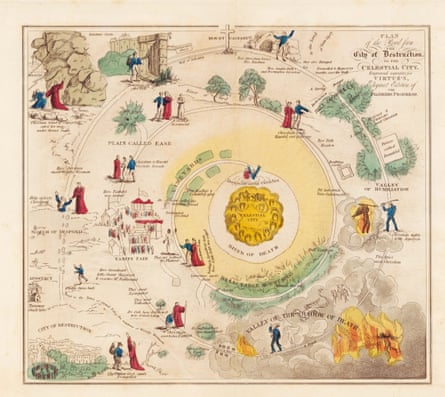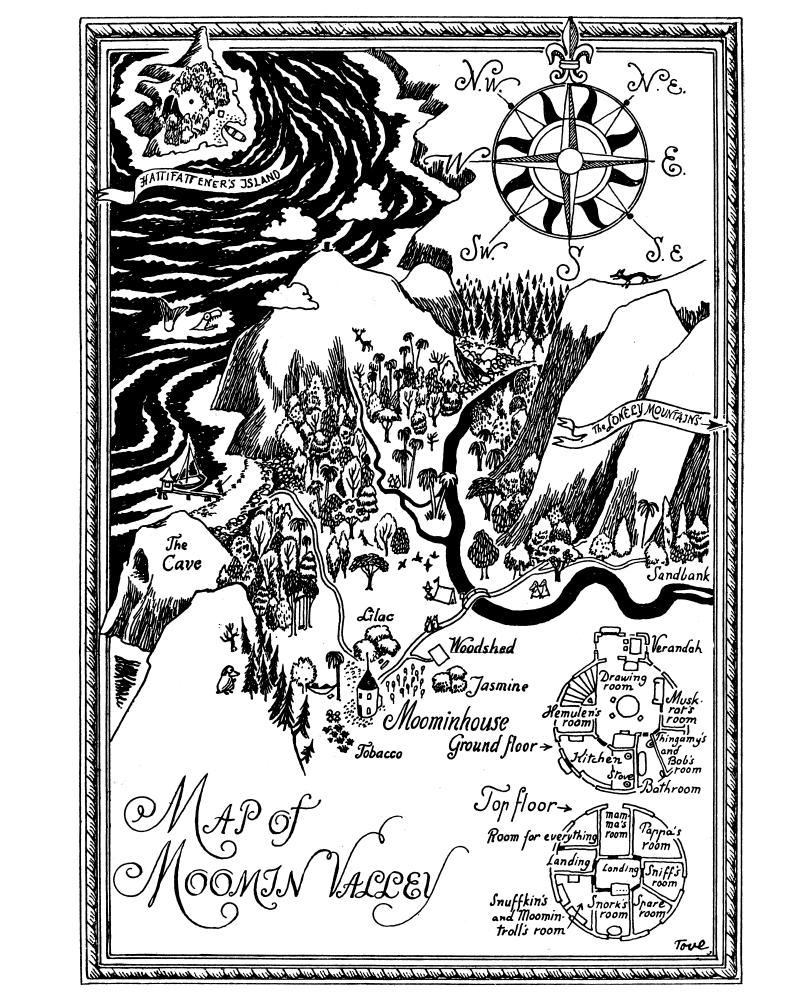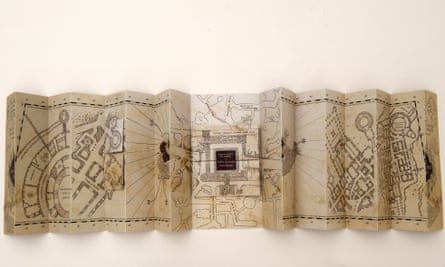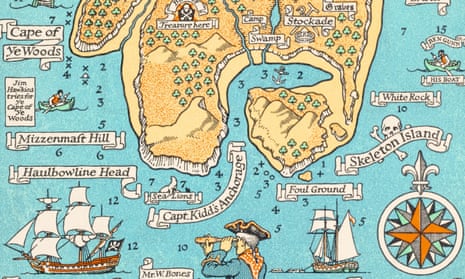X marks the spot: Robert Macfarlane on Treasure Island
In the beginning was the map. Robert Louis Stevenson drew it in the summer of 1881 to entertain his 12-year-old stepson, Lloyd Osbourne, while on a rainy family holiday in Scotland. It depicts a rough-coasted island of woods, peaks, swamps and coves. A few place names are marked, which speak of adventure and disaster: Spyeglass Hill, Graves, Skeleton Island. The penmanship is deft, confident – at the island’s southern end is an intricate compass rose, and the sketch of a galleon at full sail. Figures signal the depth in fathoms of the surrounding sea, and there are warnings to mariners: “Strong tide here”, “Foul ground”. In the heart of the island is a blood-red cross, by which is scrawled the legend “Bulk of treasure here”.
Stevenson’s map was drawn to set a child dreaming, but it worked most powerfully on its grownup author, inspiring him to write his great pirate novel, Treasure Island. Poring over the map with Lloyd, he began to populate his landscape with characters (Long John Silver, Captain Flint, Jim Hawkins) and to thicken it with plot. From that flat page sprang up one of the most compellingly realised of imaginary places. Countless children have made landfall on its blond beaches, moved cautiously through its grey woods and seen sunlight flash hard on the wild stone spires of its crags. Once visited, the island inhabits you.
We are now habituated to regard cartography as a science: an endeavour of exacting precision, whose ambition is the elimination of subjectivity from the representation of a given place. But before it was a field science, cartography was – as Stevenson proved – an art. It was an art that mingled knowledge and supposition, that told stories about places, and in which astonishment, love, memory and fear were part of its projections. It is instructive to consider these earlier artistic forms of mapping, for they exemplify neglected ways of proceeding within a landscape.
Broadly speaking, we might say there are two types of map: the grid map and the story map. A grid map places an abstract geometric meshwork upon a space, a meshwork within which any item or individual can be coordinated. The power of such maps is that they make it possible for any individual or object to be located within an abstract totality of space. Their danger is that they so reduce the world to data that they record space independent of being.

Story maps, by contrast, represent a place as it is perceived by an individual or by a culture moving through it. They are records of specific journeys, rather than describing a space within which journeys might take place. They are organised around the passage of the traveller, and their perimeters are the perimeters of the sight or experience of that traveller.
The grid map has proved an efficient method for converting place into resource, and for devising large-scale approaches to a landscape. It is a way of representing the world that has brought uncountable benefits, but so authoritative is its method, so apparently irrefutable the knowledge it dispenses about a place, that it has all but eliminated our sense of the worth of map-as-story: of cartography that is self-made, felt, sensuous.
Cultures that grow up in close correspondence with a particular terrain often develop innovative methods of representing that terrain. In 1826, at Cape Prince of Wales in the Canadian Arctic, a British naval officer encountered a hunting party of Inuit. Unable to communicate directly with the officer, but comprehending his desire for orientation, the Inuit created a map on the beach, using sticks, stones and pebbles “in a very ingenious and intelligible manner” to build a scaled replica of the region. The Inuit people are also known to have carved three-dimensional maps of coastlines from wood. In this way, the maps were portable, resistant to cold and, if they were dropped into water, would float and could be retrieved. Inhabitants of the Marshall Islands used sticks and shells, bound together with plant fibre, to create similarly buoyant accounts of the ocean currents that ran between the islands of their archipelago.
We would do well to recall these felt maps – for they are born of experience and of attention. Such maps, held in the mind, are alert to a landscape’s changeability as well as its fixtures. They tell of the inches and tints of things. They offer knowledge that might be found, as it were, off-grid. And they are sensitive to the mysterious fourth and fifth dimensions of cartography – the relationship of mapmaker to landscape, and the relationship of map-reader to map.
Snufkin in Moominland: Frances Hardinge on Tove Jansson’s map

I remember poring over the Moominland map at the front of Tove Jansson’s Finn Family Moomintroll. The map is homely, crowded and jubilantly out of scale, yet also haunting. Like the books themselves, the map always touched me with a gentle and inexplicable sadness. I imagined the Lonely Mountains isolated by their own vastness and strangeness, their slow, cold hearts filled with a drear and incurable loneliness.
But even then I noticed that one feature of the little map was not accurate, except in the sense that a stopped clock is right twice a day. Near a bridge is drawn a small tent, and beside it sits a little figure in a tapering hat. This is clearly meant to show the campsite of the green-clad, harmonica-playing Snufkin. But Snufkin cannot be pinned to a location so easily. He is an inveterate nomad, vanishing from the Moominvalley for long months at a time, then returning without warning or explanation. He was probably packing up his tent before the ink on the map had dried.
Unlike me, Snufkin never fears losing his way, because “his way” is wherever his feet lead him. He is content, intrepid, at ease. There is nowhere he needs to be, only paths he chooses as the whim takes him. He is free. About the only things that ever upset him are fences, which offend his philosophy of freedom. Fences carve up the world into this and that, yours and mine, in an attempt to tame it and make sense of it. Maps arguably do the same, and perhaps that is why Snufkin never seems to carry one.
When I first laid eyes on that Moominvalley map, I was content to let my mind swoop down into it, and never asked myself which character was supposed to have created it, or why. I never stopped to wonder whether it had been drawn by fussy Hemulen hands, or scrawled with a charred stick from some summer campfire, or lovingly sketched by Moominmamma so that young trolls could find their way home. Now, of course, I notice the extra attention paid to the layout of the Moomins’ own dwelling, and exciting details such as caves and camping spots. It is a map that a child of the Moominhouse might have drawn, with a child’s deep-seated understanding of what is important.
Back then, the map was the map, and that was all. It showed what there was, or at least what I needed to know. My fascination with the makers of maps came later. I learned to love old maps of our own world, the big, crazy, beautiful ones where countries have implausible, doughy outlines and the oceans are full of guesswork and sea monsters. In their day they must have been mind-blowing, revelatory. Now they are second cousins to the fantasy landscapes, with the same mystery and mournful sense of a place forever beyond reach. The past becomes an imaginary other-land with its own geography. You can almost sense the seams where the maps have been stitched together from travellers’ tales, other maps, rumour, legend and wishful thinking. Did it daunt those early cartographers to know that they were shaping everybody’s idea of reality? How could they cram in everything important? What was important? The glory and heroism of cartography is that it attempts the impossible. Reality is unmappable – too big, sprawling and changeable to be captured entire on paper or canvas. It’s like trying to trap a giant squid with a rock pool net.
Navigating Hogwarts: Miraphora Mina on making the Marauder’s Map

The phone rang one Monday morning. It’s remarkable to think now how the conversation that followed led to a project that would fill the next 15 years of my life. It was the production designer Stuart Craig, inviting me to join his creative team to work on the adaptation of a novel. He described the new project as a story “about a magic school, a brave young boy and a dark wizard” and left it at that.
The very first thing I created was the letter inviting Harry to Hogwarts. Mr H Potter, The Cupboard under the Stairs, 4 Privet Drive, Little Whinging, Surrey. Those words are a map in themselves, a path to an unpredictable future, an invitation into a new world. I agonised for days about the right balance of delicate marks to place on an envelope, such a simple thing really, but it was important: a handwritten address on a letter delivered by an owl to a boy who did not yet know his destiny.
Of all the things our team produced for the world of Harry Potter, the Marauder’s Map is the object that readers seem to love the most. A blank document that reveals all the secret passages of Hogwarts, it first appeared in the third novel, Harry Potter and the Prisoner of Azkaban, and we soon started thinking about how to actually make it. I knew immediately I didn’t want it to be an obvious burned-at-the-edges kind of treasure map, but rather something much more complex, multilayered.
As an object I wanted there to be a logic to opening and folding it, while it would be deliberately bewildering at the same time. A map that would confuse unless you had all the skills to decode it, as well as being a map that continued to reveal new things each time it was used. Folding paper is an artform and we engineered the map as best we could, channelling the spirit of Escher’s impossible staircases. Everything was handmade, cut, drawn and delicately sewn and glued. That’s it really: ink, paper and a great deal of care. Through the course of the films I probably made 20 copies as props. I often regretted it being so intricate, but there is no other way to make something that is beautiful and that can honour a book people love so much.
In doing so, the lines between the real and the fantasy, between the reference source and the recreated, are narrowed. The artefacts seem real, perhaps even more real. They are alive. As makers, it’s also about a totality of experience. Although many of the things we create might never be shown on screen, they are seen by the actors and “felt” by the audience.
For me, the best stories are those where real and imaginary places are constantly overlapping, colliding perhaps, the fantasy and the everyday, both magic and muggle.








Comments (…)
Sign in or create your Guardian account to join the discussion